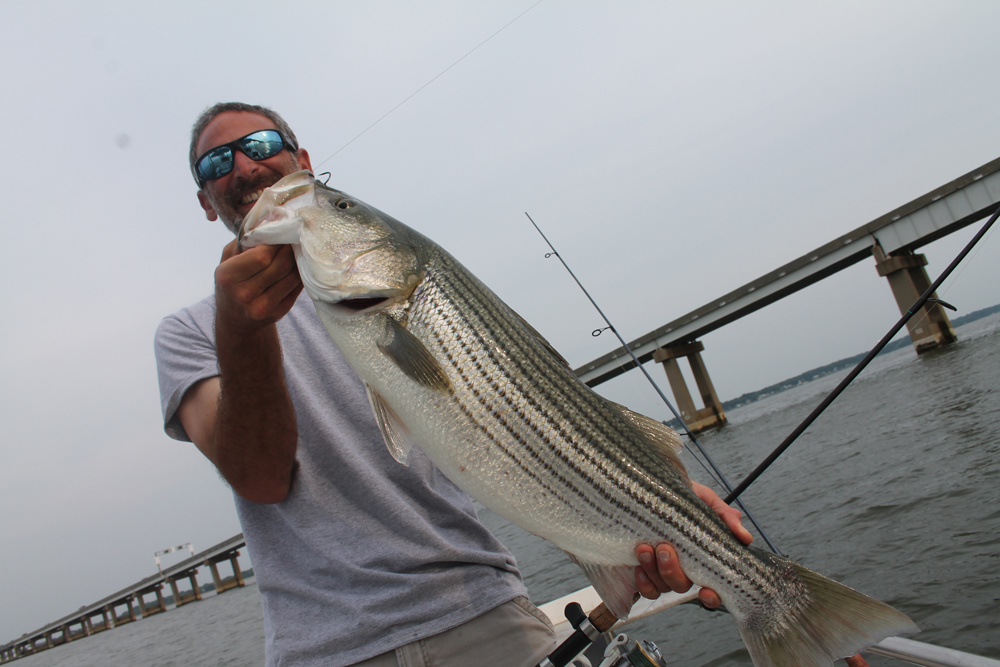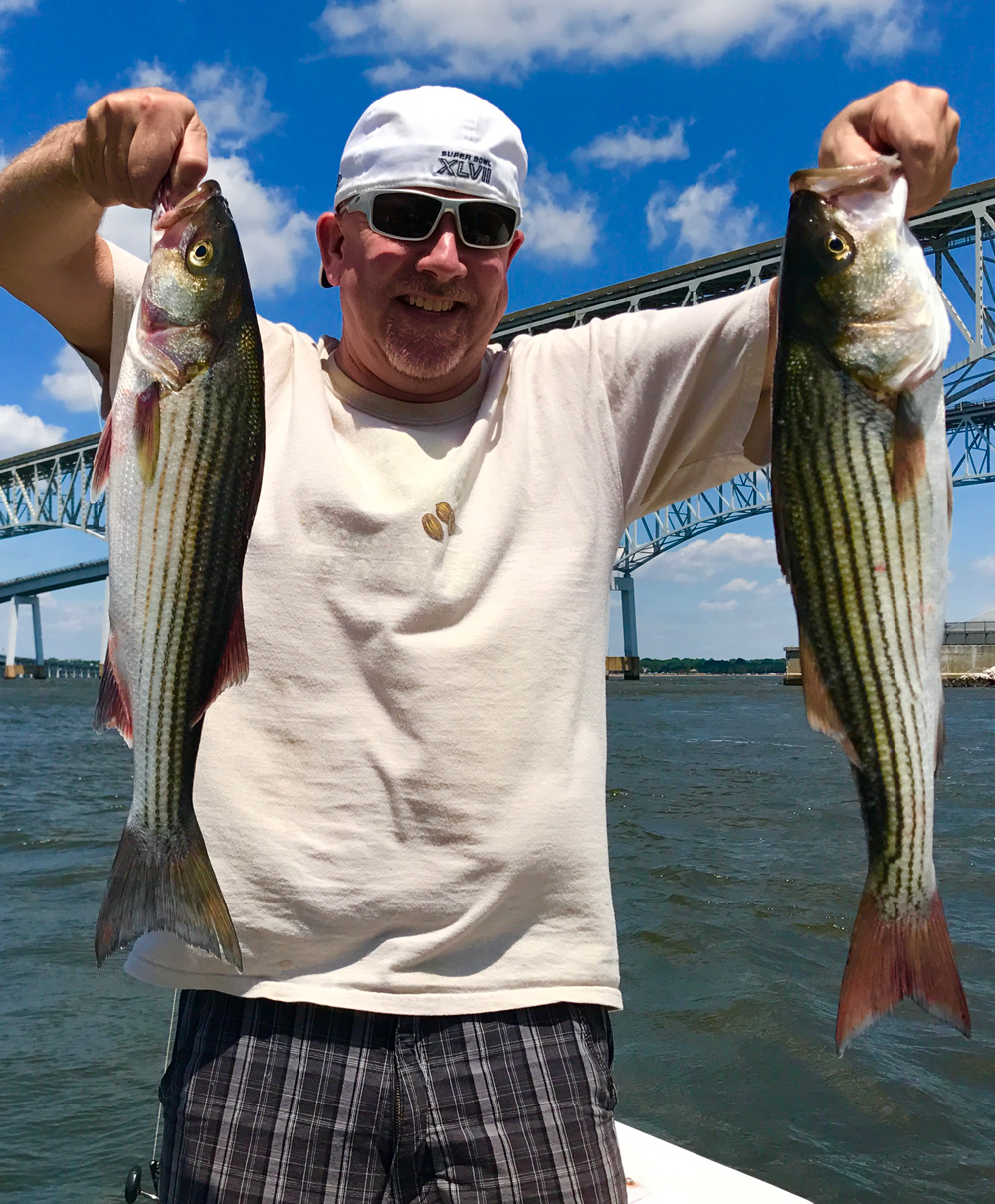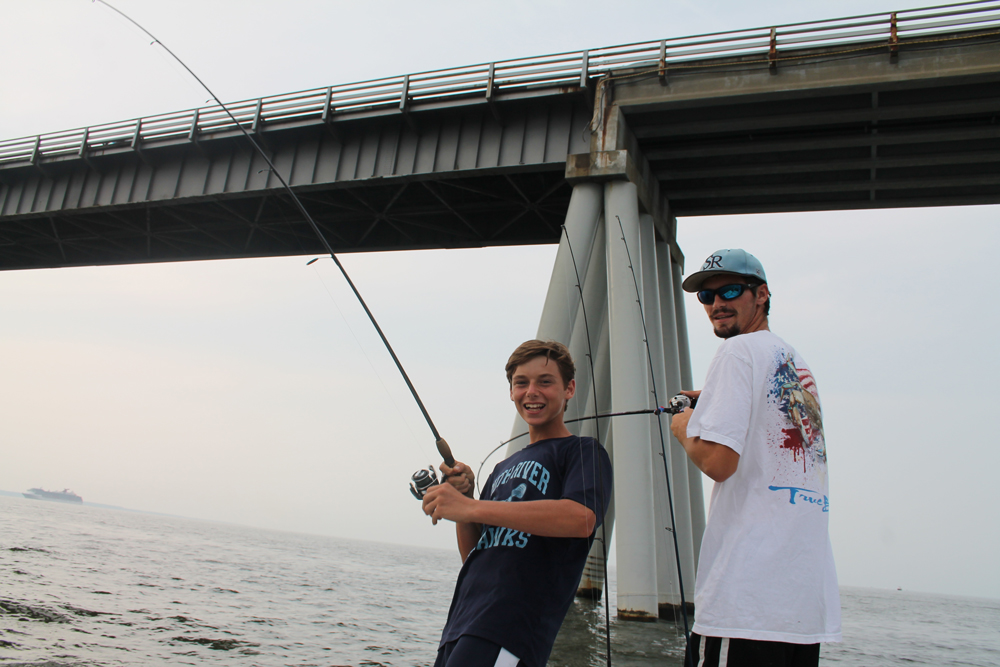You’re looking for keeper stripers in big schools, in the Upper and Middle Chesapeake Bay regions? Heading to the Chesapeake Bay Bridges might be your best choice. When the fishing is dead and all hope seems lost, fishing the pilings should be a move in any avid angler’s game-plan. With teepee-shaped pilings, underwater crossbars, and huge rock piles, the bay bridge is like a home—many homes—for the Chesapeake’s renowned striped bass. For years, these pilings have provided structure for all to reel in fish after fish, becoming a key producer for charter and recreational fisherman alike.

Bay Bridge Fodder
Let’s talk tackle, because what’s on the end of your line can be the deciding factor on whether that 30” striper ends up in your cooler. Jigging gear is based mostly on personal preference, but a standard jigging rod should be between six and seven feet, light to medium strength, and fast action so you can get a good snap on your jig and a fast hook-set on the fish. Throw on a spinning or conventional reel spooled with braid—braid is a must when jigging for stripers, you need line that won’t stretch to give your jig the best action and feel bite—then tie on a jig, and you’re ready to fish.
Finding the right lure is also key for stripers, so if you have multiple people on the boat it’s always best for everyone to start with a different lure or color to see what the fish like the most on that day. My go-to when jigging for rockfish is a BKD three-quarter-ounce jighead with a white six-inch BKD tail, but I always make sure to test out different colors because the fish will act different every day. When bluefish start to come in and tear up your lures it’s essential to have a pack of Z-Man tails on the boat because the fish can’t bite through them, which not only saves you money but makes you more likely to hook that monster bluefish. Switching over to metal lures is also a good alternative when your gear is getting shredded.
Piling it On
Now that your tackle’s set up, you’re ready to cast. Fish at the can be finicky, and sometimes the only way to get the fish to bite is to drop those lures right in front of their faces. A common mistake many anglers make is to start reeling the moment their lure hits the water, each and every cast. Whenever you’re casting between pilings or casting at the rock piles, test different depths and retrieve styles. Sometimes up top is the most effective method, except when it’s not. There have been many days I have fished the bridge and couldn’t catch a fish over 12 inches high in the water column, but after letting my lure sink and get under the dinks, keepers started coming into the boat one after the other. This is because the larger fish are smarter and lazy, so they let little fish do all the work and eat scraps that fall down below. This is true not only for the bridge, but jigging and casting in general on suspended and breaking fish.

The action and speed of your retrieve are just as imperative as depth, so make sure you change it up until you find exactly what the fish like. If you can get the right lure and dial in what depth, action, and speed the fish like that day, you’re in for a heck of a day fishing at the bridge. Remember, however, that the current rips through the bridge and sometimes it’s so strong the captain may want to consider just handling the boat and not even casting. Setting up your drift on the down-current side so you can start close to the pilings and drift away from them will help, if you want to be able to cast without worrying about holding the boat in position.
Teepee Bridge Pilings
The teepee-shaped pilings, with multiple legs going down at an angle and becoming farther apart the deeper they get, are often a good bet for jiggers. When fishing these teepees you can position the boat just north or just south of them and cast right up between the legs. You can also let your lure sink in this scenario, and don’t worry about snagging because there is no structure in-between the legs. Remember, however, if you hook a fish between the legs of the teepee pilings haul it out as fast as you can, or they may wrap your line around a piling and snap off.
Sometimes you can hit 10 or 12 and only one set of the pilings holds all or most of the fish. You’ll usually find out pretty fast if there are any fish willing to bite at a specific teepee, so if you take two or three casts to either side and down the middle without getting a bite, move on sooner rather than later.
H-shaped Bridge Pilings
The H-shaped pilings are another good bet, especially if you can cast between the legs of the H. But in this case make sure to keep you retrieve a little speedy otherwise you could lose your lure on the underwater crossbars. Every H-piling has crossbar about 10 feet down, which big rockfish love to hide under. If you’re looking to hook that monster and you’re confident with a jig, try to cast between the legs and let your jig sink until it’s close this underwater crossbar. You’ll want to use a fairly heavy head for this to sink to the fish’s depth before the current sweeps your jig into the side of the piling, but bring plenty of extra tackle, because this does lead to a lot of snags.
Rockpiles at the Bridge
The rockpiles are another fish-attractor. Sometimes the western one is better and other times the eastern one is; it just depends on where the fish want to be. Often they’ll be up-current of the rockpiles or off to one side or the other, and much of the time you’ll find them suspended deep. When you first arrive at the rockpiles it’s a good idea to circle around them once with an eye on the fishfinder, and see if you can spot the area they’re congregated in before you start casting.
If you arrive at the rockpiles (or any of the pilings, for that matter) and the current is dead, it’s usually a good idea to stick around. The current never stays slack for very long here, and in a matter of minutes it’s sure to begin running again. But when the current has stopped, the rockpiles can still be a good place to be. If you locate fish on the meter you can tie on a tandem rig, and vertically jig right on top of the fish. Tip: if you like white perch, try jigging a tandem rig with a shad dart or a short streamer for the top lure, because there are often lots of perch around the rockpiles, too.
Although they aren’t productive regularly enough to merit their own section in this article, when you’re at the rockpiles, it’s also worth taking a few casts at the huge concrete pilings directly across from them. Particularly on an outgoing tide, rockfish sometimes stack up on one corner or another of these pilings. It also seems like you see fish breaking water around them more often than around the other pilings, so always stay on the lookout for action at the surface.
The Sewer Pipe
Although it isn’t actually attached to the bridge, the Sewer Pipe is so close by you’ll often want to try there after hitting the bridge itself. The pipe outflow is marked by small orange/white buoys, but the important thing to remember here is that the outflow isn’t usually the very best spot to fish. The pipe is protected by a ridge of rocks piled on top of it, which runs east-west from the marker towards shore. Anywhere and everywhere along this ridge is worth checking out.
Fish will usually be found along one part of the ridge or another, but not all along it. So the best way to approach this area is to slowly motor down the ridge while zig-zagging back and forth across it, looking for fish on the meter. When you spot them, shift into neutral and start casting. A warning, though, don’t try to anchor here unless you have a grappling anchor you can bend out—lots of people have lost their anchor, at the Sewer Pipe!

When the fish aren’t biting elsewhere and all hope seems lost, the bridge can be your saving grace—if you know how to fish it. With one of the strongest currents in the bay ripping through and loads of structure, it is almost impossible to find a day where you can’t find at least fish or two under the bridge. Plus, with more and more traffic to the eastern shore every year, we can rest assured knowing that this legendary spot is here to stay.
Sign up here to get the weekly FishTalk Chesapeake Bay and Mid-Atlantic fishing reports in your email inbox, every Friday by noon.